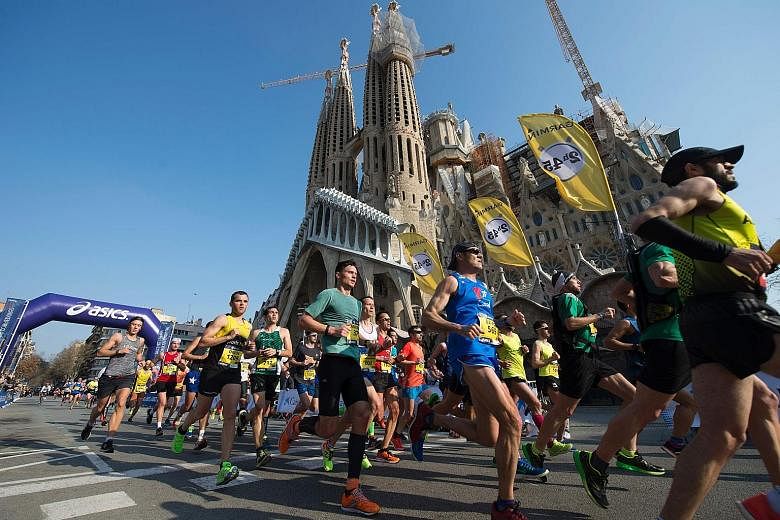Lowering the men's marathon world record to below two hours could be easier than some experts have predicted, according to a timely new study of how to run fast.
Of almost equal interest, the rest of us could use a few simple tweaks to improve our own, admittedly more pedestrian race times.
The world record for the 42.195km distance, set by Dennis Kimetto of Kenya in 2014, is 2hr 2min 57sec. To shave close to three minutes from that time and drop below two hours, the study finds, may require only a few simple adjustments to elite runners' racing strategies and equipment.
Several programmes, some funded by running shoe companies, are working with small groups of world-class male runners in an attempt to shatter the two-hour barrier. To date, much of the effort in these programmes has focused on improving runners' strength and endurance through longer or more strenuous training.
However, some scientists have begun to ask whether it might be worthwhile to focus more intently on other aspects of running and, in particular, economy.
In simple terms, running speed depends on both a runner's aerobic capacity and his or her running economy, also known as efficiency. If one athlete is more efficient than another, his body can use less energy to go at the same pace as the other runner and he should be able to run longer or harder.
For the new study, which was published recently in Sports Medicine, researchers from the University of Colorado in Boulder and the University of Houston decided to calculate the time savings that might be achieved by a series of surprisingly simple changes to how racers run and whether these would be sufficient, by themselves, to get top marathon runners below two hours.
They began by considering the environment, which can have an outsize effect on running speed. Headwinds and hills reduce efficiency. So one quick way to improve efficiency and speed, they write, is to run downhill.
-
3
Researchers and running programmes are working on shaving just under three minutes off the the current world record to get the first marathon in less than two hours.
The current world record was set in the Berlin Marathon, which is mostly flat or downhill. International sports regulations specify that, for world-record consideration, a course cannot drop more than about 42m (originally 140 feet) from beginning to end.
But a marathon course with precisely that drop in altitude would allow an elite runner to be about 1 per cent more efficient and faster, the researchers calculate.
Reducing wind resistance would provide an even greater boost, they next determined. Specifically, if every racer in a small lead group ran for about three minutes at the head of a line of other runners and then dropped to the back of that group, as bike racers do in a pace line, the runners would all be faster than if they ran side by side.
Each racer would use more energy than normal while at the head of the line, since he would be blocking the wind for the others, but would conserve a great deal of energy when tucked in behind the other runners, producing a significant net improvement in efficiency, the researchers calculated.
Finally, they found that by changing shoes, marathoners could very easily increase their speed. Shoes are costly, in terms of efficiency. It takes energy to swing legs, and the energy demands are amplified if weight is on the foot.
In past studies, the Colorado researchers had found that adding 100 grams to the weight of a shoe reduces a runner's efficiency by about 1 per cent.
Lighter shoes make more efficient runners. When Kimetto set the world record, he wore shoes that weighed about 244g each, the researchers write. Had his shoes been 100g lighter, he might have run the same course a minute faster, they conclude.
Interestingly, running barefoot is not necessarily better for efficiency than lightweight shoes, the researchers point out, since a barefoot runner's foot and leg muscles work harder to offset the absence of cushioning that otherwise comes from shoes.
Taken together, these strategies could potentially improve a world-class racer's efficiency by almost 3 per cent in a given marathon, the researchers calculate, which should reduce their finishing times by nearly four minutes and easily drop the world record below two hours.
Given this data, "I think we will see a sub-two-hour marathon a lot sooner than many people think," said Rodger Kram, a professor of biomechanics at the University of Colorado, Boulder, who conducted the study with Wouter Hoogkamer, a postdoctoral researcher at the same school, and Christopher Arellano, a professor at the University of Houston.
In the meantime, Kram says, these strategies might also substantially improve efficiency and race times for the rest of us. Look for a marathon that advertises itself as having a downhill course, he says.
Running the California International Marathon in Sacramento, for instance, which drops about 103m (340 feet) from start to finish, could allow a four-hour marathon runner to shave about 21/2 minutes from his or her finishing time, compared with running a completely flat course, Hoogkamer estimates.
Similarly, convincing a few fellow runners to join you in a pace line during the marathon might shave nearly four minutes from your time if you normally finish in four hours, Hoogkamer says.
Finally, lighter shoes could lower your time by another minute or so, although it's wise to break in any new shoes well in advance of race day, to avoid blisters or other problems.
NYTIMES

